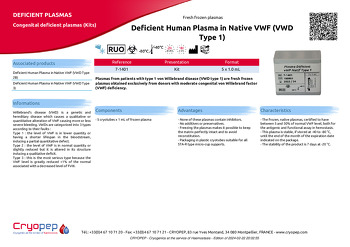HEMOSTASIS COAGULATION RESEARCH REAGENTS DEFICIENT PLASMAS CONGENITAL DEFICIENT PLASMAS (KITS)
Deficient Human Plasma in Native VWF (VWD Type 1)
Plasmas from patients with type 1 von Willebrand disease (VWD type 1) are fresh frozen plasmas obtained exclusively from donors with moderate congenital von Willebrand factor (VWF) deficiency.
Advantages
- None of these plasmas contain inhibitors.
- No additives or preservatives.
- Freezing the plasmas makes it possible to keep the matrix perfectly intact and to avoid reconstitution.
- Packaging in plastic cryotubes suitable for all STA-R type micro-cup supports.
Informations
Willebrand's disease (VWD) is a genetic and hereditary disease which causes a qualitative or quantitative alteration of VWF causing more or less severe bleeding. VWDs are categorized into 3 types according to their faults :
Type 1 : the level of VWF is in lower quantity or having a shorter lifespan in the bloodstream, inducing a partial quantitative defect.
Type 2 : the level of VWF is in normal quantity or slightly reduced but it is altered in its structure inducing a qualitative deficit.
Type 3 : this is the most serious type because the VWF level is greatly reduced <1% of the normal associated with a decreased level of FVIII.
Documentation
Download the product sheetPrice list, safety data sheets and notices are accessible to our registered customers.

Fresh frozen plasmas








References
| 7-1401 | Kit | 5 x 1.0 mL |

















